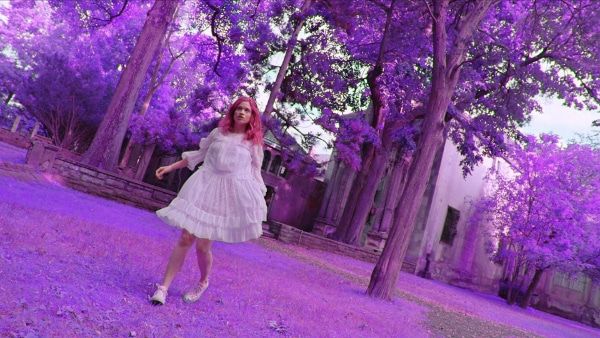Eye For Film >> Movies >> Braid (2018) Film Review
Braid
Reviewed by: Jennie Kermode

Although they used to be commonplace, a practical way of keeping long hair from getting dirty, one rarely sees braids on adults today; instead we associate them with childhood, with Japanese schoolgirls or their western equivalent a century ago. One can actually make a braid using as many strands as one wants, but the classic braid has three, and Mitzi Peirone's ambitious début feature weaves together the stories of three young women who are still, in their different ways, bound to childhood.
Tilda (Sarah Hay) and Petula (Imogen Waterhouse) are petty criminals. They have found themselves in a situation where they owe money to the wrong man, and we get the impression that it's not fr the first time. Needing to get out of the city for a bit, they decide to visit the crumbling mansion whose sole occupant is their childhood friend Daphne (Madeline Brewer), a lonely heiress who just might have a large sum of money stashed in her safe. The problem? Daphne is mad, and the only way they're going to get to stay in the house long enough to seek their prize is to join in with her favourite childhood game.
It's not just cinema that enjoys stories about childhood. We tell them to ourselves and one another all the time. Most notably, we cling to the notion that children are innocent. Daphne's game quickly reveals the absurdity of that. Don't you remember? Childhood is frequently a time of unrestrained violence, a time when we find out where the edge is by continually testing, provoking, daring. In this, girls are no different from boys. Daphne likes a game in which she plays mother with Tilda as her little girl, Petula as a visiting doctor and her sometime paramour. This might sound gentle but the unschooled practice of medicine can take a toll on the body, and that's before we even get to the consequences of being pushed out of a treehouse.
Tilda is an addict. She copes with life by getting high, allowing Peirone to get playful with a long PCP-inspired hallucinatory sequence in shades of violet - but everybody here is addicted to something and delusions abound. Over the course of the film, the narrative twists and turns as if itself passing through a braid. The viewer must continually re-evaluate what is going on. These curves spill out into the film's visual aesthetic, giving us flower petals, arches, curling strands of wrought iron, courtyards glimpsed through fish eye lenses, sublimely fashion-conscious bondage gear. The iconography of the feminine is twisted into something deadly. Men are at most a temporary intrusion; the young women revolve around one another as, perhaps, they always have. And as always when the feminine comes to the fore like this, there is a lot of blood.
Visually and thematically strong, the film is not as successful when it comes to character development. It sets up so many layers of illusion and self-delusion that it's hard for us to get to now its protagonists despite solid acting work. To an extent, this absence of character is clearly deliberate - it's what the three form when they are together that really matters, and the question of whether or not it's possible to escape from that - whether or not any of them can survive alone - becomes a central preoccupation. Nevertheless, a bit more soul would have added to its staying power. Beautiful and erotic as it is, it easily beguiles the viewer but then just as easily slips away again.
Reviewed on: 25 Jan 2019
















